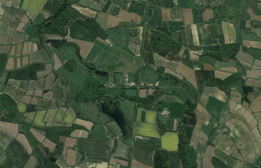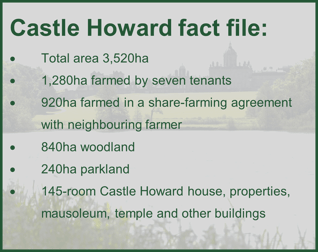Using science and data to create a natural capital baseline is helping a North Yorkshire estate drive its ambitions to become more environmentally sustainable and profitable for the long-term.

Castle Howard is working with Fera Science’s LAND360 team to map out the biodiversity and carbon footprint of the 9,000-acre (3,520ha) mixed-use estate, consisting of farmland, woodland and parkland.
Jasper Hasell, estate chief executive at Castle Howard, hopes that by having an accurate picture of the existing landscape, the estate team can adapt their management practices to increase carbon sequestration, enhance the natural environment, and support its tenant farmers.
The team at Castle Howard also hope it will put them in a good position to apply for environmental schemes such as the Local Nature Recovery and Landscape Recovery schemes — two elements of the Environmental Land Management (ELM) schemes which are replacing the Basic Payment Scheme (BPS).
Building a natural capital baseline
Jasper explains that getting a clear understanding of the landscape’s natural capital fits into the estate’s tree-pillared strategy:
1. Restoring the estate’s heritage
2. Regenerating the landscape and soils
3. Reviving the estate’s rural communities
Having always looked to data to guide their strategy, Jasper and his team plan to put the information from Fera
Science’s LAND360 landscape assessment, which uses satellite imagery to scientifically assess habitat parcels contained in the estate, at the heart of their plans.
As part of the process, Fera Science ecologists also went on-site to assess areas of the land in person, resulting in a natural capital assessment with 95% accuracy.
“That level of accuracy is pretty incredible,” Jasper says. “The benefit to us is we have a rich baseline from which we can make decisions, and that can help us determine how we change certain land management operations.
“If we’re farming in a way that’s not good for sequestering carbon, for example, we can look at what changes we can make to alter that.
Having a baseline gives us a tool from which we can measure the progress of changes we make.”
With the estate facing demands from its rental property tenants, its tenant farmers, and visitors who want to enjoy the estate’s heritage and landscape, the Castle Howard team has multiple factors it needs to balance as part of their land management strategy.

Focus on soil health
However, with science-backed data at the core of their strategy, Castle Howard can now plan their next steps, which include a detailed soil baseline to complement their natural capital information.
“The next stage is about the soil health, the carbon store within soils, the biology and general health so we can make improvements to our land management and soils,” Jasper explains.
“Fera is working with us to devise a programme so we can measure changes every 2-3 years to see our progress.

“The next piece of the jigsaw is scenario testing,” he adds. “So that’s understanding what we do with different land parcels, what’s the best decision in terms of land use, and how that meets objectives — whether that’s carbon sequestration, biodiversity, or gross margins in terms of profitability.”
For more information on how LAND360 could be used within your business contact our team.
Other blogs of interest: